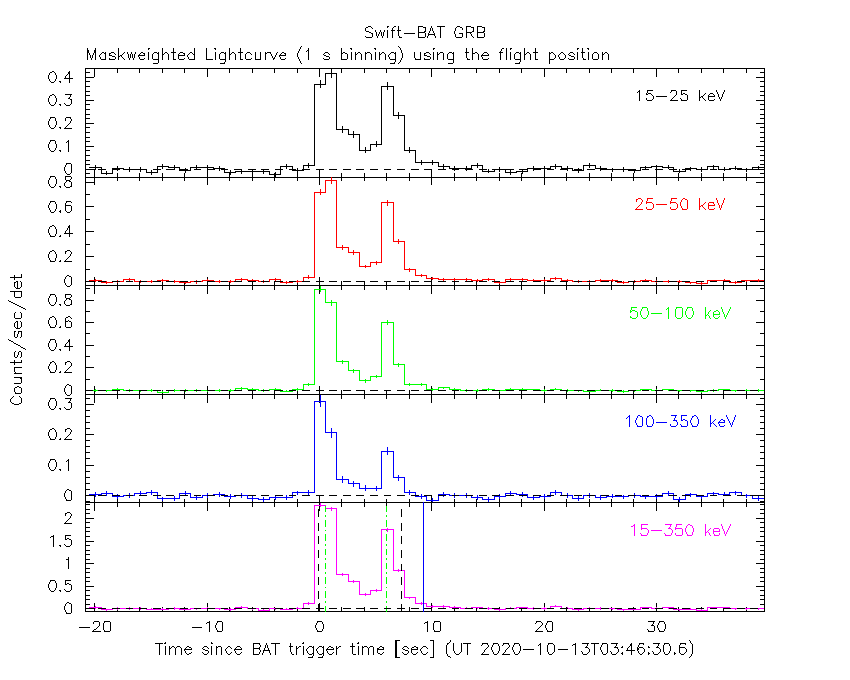
K.L. Page (U. Leicester), P.A. Evans (U. Leicester) and A.A. Breeveld (UCL-MSSL) for the Swift team
At 03:46:30 UT, the Swift Burst Alert Telescope (BAT) triggered and located GRB 201013A (trigger=999948) (Page et al. GCN Circ. 28607). Swift slewed immediately to the burst. At the time of the trigger, the initial BAT position was 97° from the Sun (6.1 hours West) and 53° from the 19%-illuminated Moon. Table 1 contains the best reported positions from Swift, and the latest XRT position can be viewed at http://www.swift.ac.uk/xrt_positions.
Table 2 is a summary of GCN Circulars about this GRB from observatories other than Swift.
Standard analysis products for this burst are available at https://gcn.gsfc.nasa.gov/swift_gnd_ana.html.
As reported by Laha et al. (GCN Circ. 28614),
the BAT ground-calculated position is RA, Dec = 107.392, 57.031 deg which is RA(J2000) = 0
The mask-weighted light curve (Figure 1) shows a double-peaked structure that starts at ~T-1 s and ends at ~T+10 s.
The two main peaks occur at ~T+0.5 s and ~T+6.5 s, respectively.
The time-averaged spectrum from T-0.85 to T+9.64 s is best fit by a simple power-law model.
The power law index of the time-averaged spectrum is 1.22 ± 0.04.
The fluence in the 15-150 keV band is 6.7 ± 0.1 x 1
The results of the batgrbproduct analysis are available at https://gcn.gsfc.nasa.gov/notices_s/999948/BA/.
Analysis of the initial XRT data was reported by Evans et al. (GCN Circ. 28611). We have analysed 15 ks of XRT data for GRB 201013A, from 89 s to 127.7 ks after the BAT trigger. The data are entirely in Photon Counting (PC) mode. The enhanced XRT position for this burst was given by Beardmore et al. (GCN Circ. 28608).
The light curve (Figure 2) can be modelled with an initial power-law decay with an index of α=0.54 (+0.25, -0.34), followed by a break at T+609 s to an α of 0.99 (+0.15, -0.05).
A spectrum formed from the PC mode data can be fitted with an absorbed power-law with a photon spectral index of 2.02 (+0.28, -0.27). The best-fitting absorption column is 4.3 ± 0.7 x 1
A summary of the PC-mode spectrum is thus:
Total column: 4.3 ± 0.7 x 1
Galactic foreground: 5.4 x 1
Excess significance: 10.4 σ
Photon index: 2.02 (+0.28, -0.27)
The results of the XRT team automatic analysis are available at http://www.swift.ac.uk/xrt_products/00999948.
The Swift/UVOT began settled observations of the field of GRB 201013A 74 s after the BAT trigger
(Breeveld and Page GCN Circ. 28613).
There is a bright optical source (USNO B1.0 1470-0207304) 0.5 arcsec from the enhanced XRT position (Beardmore et al. GCN Circ. 28608).
Table 3 gives preliminary
magnitudes using the UVOT photometric system
(Breeveld et al. 2011, AIP Conf. Proc., 1358, 373).
No correction has been made for the expected extinction in the Milky Way
corresponding to a reddening of

Figure 1. The BAT
mask-weighted light curve in the four individual and total
energy bands. The units are counts

Figure 2. The XRT light curve.
Any data from a crosshatched region are not included in the fit.
| RA (J2000) | Dec (J2000) | Error | Note | Reference |
|---|---|---|---|---|
| 0 |
+57°02'03.4" | 1.4" | XRT-final | UKSSDC |
| 0 |
+57°02'03.2" | 1.9" | XRT-enhanced | Beardmore et al. GCN Circ. 28608 |
| 0 |
+57°01'52.4" | 1.0' | BAT-refined | Laha et al. GCN Circ. 28614 |
| Band | Authors | GCN Circ. | Subject | Observatory | Notes |
|---|---|---|---|---|---|
| Optical | Lipunov et al. | 28612 | Swift GRB 201013A: Global MASTER-Net observations report |
MASTER | |
| Optical | Jelinek et al. | 28615 | FRAM-ORM possible afterglow candidate | FRAM | possible detection |
| Optical | Belkin et al. | 28621 | TSHAO and AbAO optical observations, afterglow confirmation |
Abastumani Astro. Obs. | detection |
| Optical | Gupta et al. | 28686 | 3.6m DOT Optical Observations | Devasthal Opt.Tel. | |
| Gamma-ray | Tamura et al. | 28618 | CALET Gamma-Ray Burst Monitor detection | CALET | |
| Gamma-ray | Gupta et al. | 28620 | AstroSat CZTI detection | CZTI | |
| Gamma-ray | Zheng et al. | 28625 | Insight-HXMT/HE detection | Insight-HXMT | |
| Gamma-ray | Tsvetkova et al. | 28652 | Konus-Wind observation | Konus-Wind | Fluence=2.77(-0.33,+0.37)x1 |
| Filter | Exp(s) | Mag | ||
|---|---|---|---|---|
| whit |
74 | 223 | 147 | >16.8 |
| 286 | 535 | 246 | >16.7 | |
| white | 74 | 1712 | 412 | >16.8 |
| v | 616 | 1763 | 136 | >16.2 |
| b | 541 | 1686 | 117 | >16.6 |
| u | 286 | 1662 | 343 | >16.7 |
| w1 | 665 | 1804 | 127 | >16.6 |
| m2 | 640 | 1611 | 58 | >16.7 |
| w2 | 591 | 1738 | 136 | >17.1 |
Table 3. UVOT observations reported by Breeveld and Page (GCN Circ. 28613). The start and stop times of the exposures are given in seconds since the BAT trigger. The preliminary 3-σ upper limits are given. No correction has been made for extinction in the Milky Way.
October 20, 2020